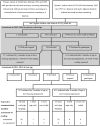The impact of universal newborn hearing screening on long-term literacy outcomes: a prospective cohort study
- PMID: 25425604
- PMCID: PMC4717422
- DOI: 10.1136/archdischild-2014-307516
The impact of universal newborn hearing screening on long-term literacy outcomes: a prospective cohort study
Abstract
Objective: To determine whether the benefits of universal newborn hearing screening (UNHS) seen at age 8 years persist through the second decade.
Design: Prospective cohort study of a population sample of children with permanent childhood hearing impairment (PCHI) followed up for 17 years since birth in periods with (or without) UNHS.
Setting: Birth cohort of 100 000 in southern England.
Participants: 114 teenagers aged 13-19 years, 76 with PCHI and 38 with normal hearing. All had previously their reading assessed aged 6-10 years.
Interventions: Birth in periods with and without UNHS; confirmation of PCHI before and after age 9 months.
Main outcome measure: Reading comprehension ability. Regression modelling took account of severity of hearing loss, non-verbal ability, maternal education and main language.
Results: Confirmation of PCHI by age 9 months was associated with significantly higher mean z-scores for reading comprehension (adjusted mean difference 1.17, 95% CI 0.36 to 1.97) although birth during periods with UNHS was not (adjusted mean difference 0.15, 95% CI -0.75 to 1.06). The gap between the reading comprehension z-scores of teenagers with early compared with late confirmed PCHI had widened at an adjusted mean rate of 0.06 per year (95% CI -0.02 to 0.13) during the 9.2-year mean interval since the previous assessment.
Conclusions: The benefit to reading comprehension of confirmation of PCHI by age 9 months increases during the teenage years. This strengthens the case for UNHS programmes that lead to early confirmation of permanent hearing loss.
Trial registration number: ISRCTN03307358.
Keywords: Deafness; Neurodevelopment; Outcomes research; Screening.
Published by the BMJ Publishing Group Limited. For permission to use (where not already granted under a licence) please go to http://www.bmj.com/company/products-services/rights-and-licensing/
Figures


Comment in
-
The impact of universal newborn hearing screening.Arch Dis Child. 2016 Jan;101(1):1-2. doi: 10.1136/archdischild-2014-307867. Epub 2015 Sep 7. Arch Dis Child. 2016. PMID: 26347388 No abstract available.
-
Early detection of hearing impairment reflected in better reading ability in teenage years.Evid Based Med. 2016 Aug;21(4):155. doi: 10.1136/ebmed-2016-110466. Epub 2016 Jul 11. Evid Based Med. 2016. PMID: 27402870 No abstract available.
References
-
- Davis A, Bamford J, Wilson I, et al. A critical review of the role of neonatal hearing screening in the detection of congenital hearing impairment. Health Technol Assess 1997;1:i–iv, 1–176. - PubMed
-
- Eisenberg LS. Current state of knowledge: speech recognition and production in children with hearing impairment. Ear Hear 2007;28:766–72. - PubMed
-
- Moeller MP, Tomblin JB, Yoshinaga-Itano C, et al. Current state of knowledge: language and literacy of children with hearing impairment. Ear Hear 2007;28:740–53. - PubMed
-
- Luckner JL, Cooke C. A summary of the vocabulary research with students who are deaf or hard of hearing. Am Ann Deaf 2010;155:38–67. - PubMed
-
- Luckner JL, Handley CM. A summary of the reading comprehension research undertaken with students who are deaf or hard of hearing. Am Ann Deaf 2008;153:6–36. - PubMed
Publication types
MeSH terms
Associated data
Grants and funding
LinkOut - more resources
Full Text Sources
Other Literature Sources
Medical
Miscellaneous
